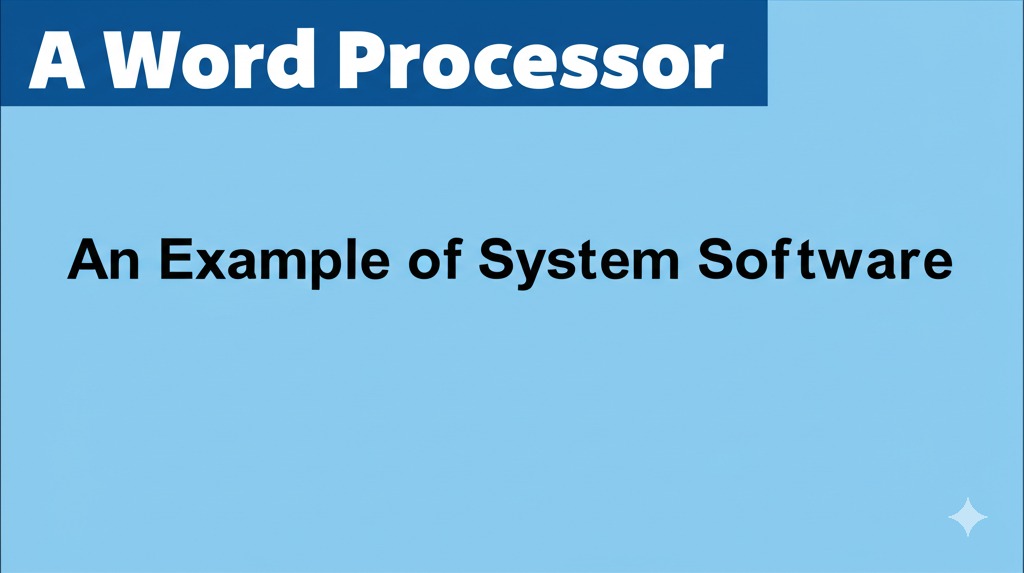A Word Processor: An Example of System Software
In today’s digital world, software plays an essential role in making our lives easier and more productive. From creating documents to managing data, software solutions have become vital tools for both personal and professional use. One such tool is the word processor, a widely-used application that allows users to create, edit, and format text documents. But did you know that a word processor is considered an example of system software? In this article, we’ll dive into the concept of system software, explore the role of word processors, and discuss how they fit into the broader category of system software.
What Is System Software?
Before we jump into understanding the role of word processors, it’s important to define what system software is.
Understanding System Software
System software refers to the collection of programs designed to manage and control the hardware components of a computer system. Unlike application software, which performs specific tasks for the user (such as editing text or creating graphics), system software acts as an intermediary between the user and the hardware, ensuring that the system functions efficiently.
Types of System Software
There are several types of system software, including:
- Operating Systems (OS): The most well-known example, such as Windows, macOS, or Linux. The OS manages hardware, provides essential services, and runs applications.
- Device Drivers: These allow hardware components (like printers or graphics cards) to communicate with the operating system.
- Utility Software: Tools like antivirus programs or disk cleanup tools that help maintain and optimize the computer’s performance.
A Word Processor as System Software
Now that we understand the basics of system software, let’s focus on the role of a word processor. While a word processor is typically considered application software, it can also be classified as system software in certain contexts. Here’s why:
Word Processors and Their Relationship to the Operating System
Word processors, like Microsoft Word or Google Docs, run on top of an operating system and rely on it for key functions like file storage, memory management, and hardware interaction. For instance, the operating system enables the word processor to open and save documents, access fonts, and print documents. Without system software like the operating system, a word processor wouldn’t function.
Integrating with System Resources
While a word processor might appear to be an application designed solely for text editing, it heavily relies on system software for its operation. For example:
- Memory management: The operating system allocates memory resources to the word processor, ensuring it runs smoothly even when handling large documents.
- File management: System software helps the word processor save, open, and organize documents within the file system, ensuring documents are stored properly.
- Printer management: System software communicates with the printer to ensure that documents are printed correctly and efficiently.
Thus, while the primary purpose of a word processor is to assist users with document creation and editing, its operation is intricately tied to system software components that facilitate its functionality.
Key Features of Word Processors
User Interface
Word processors provide an intuitive user interface (UI) that allows users to interact with the software effectively. The UI often includes a text area for typing, formatting options like bold or italics, and tools for inserting images or tables. The smooth operation of this interface depends on system software to manage the rendering and interactions on the screen.
File Compatibility and Storage
A major benefit of word processors is their ability to create, edit, and save files in various formats. These files are stored and managed by the system software, which controls how and where data is saved on storage devices like hard drives or cloud storage. Word processors also allow users to open files created on different devices, ensuring compatibility across different platforms.
Advanced Features
Many word processors also offer advanced features like spell checking, grammar correction, and even voice typing. These functionalities, while user-friendly, are powered by system-level tools such as memory management, networking protocols, and access to external APIs for language processing.
How Word Processors Improve Productivity
Increased Efficiency
By automating the formatting and editing processes, word processors streamline the document creation experience. Features like templates, spell check, and auto-correction save users valuable time and effort.
Collaboration Tools
With the rise of cloud-based word processors like Google Docs, real-time collaboration has become possible. Multiple users can work on the same document simultaneously, thanks to the system software that facilitates seamless synchronization between users and devices. This fosters greater teamwork and increases overall productivity.
Document Organization
Word processors provide easy-to-use organizational tools such as folders, tags, and file formats (e.g., .docx, .pdf) that help users keep their documents well-organized. These systems depend on the operating system’s file management system to keep track of file locations and maintain accessibility.
Why System Software Is Crucial for Word Processors
Stability and Reliability
System software plays a significant role in ensuring the stability and reliability of word processors. The operating system monitors the hardware and software, troubleshooting issues, and ensuring that the word processor runs smoothly without interruptions or crashes.
Security
System software is essential for securing word processor documents. By implementing features like user authentication and data encryption, the operating system helps protect sensitive documents from unauthorized access and cyber threats.
Resource Management
Efficient resource management is key to making sure a word processor operates smoothly. System software ensures the word processor has access to enough system resources like CPU, RAM, and storage to operate efficiently, even when handling complex or large files.
Conclusion
A word processor may seem like a simple tool for creating documents, but it heavily relies on system software for its functionality and smooth operation. From memory management and file storage to security and printer communication, system software plays an essential role in ensuring that word processors run seamlessly. Understanding this relationship not only highlights the importance of system software in our daily tasks but also showcases how interconnected modern technology truly is.
If you’ve ever used a word processor to draft a report or craft a novel, remember that it’s not just the software you’re using—it’s the system software behind it that enables everything to work efficiently. So, the next time you open your word processor, take a moment to appreciate the critical role system software plays in making your work possible.

Zain Jacobs is a writer for TheNetUse, providing in-depth reviews, tips, and insights on the latest software apps to help users maximize their digital experience.







